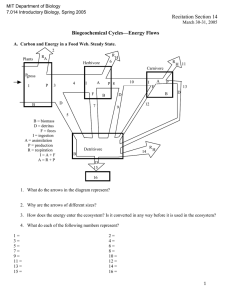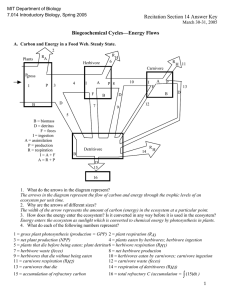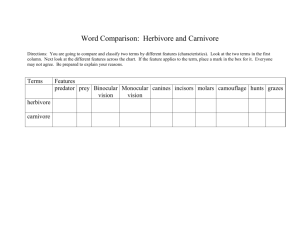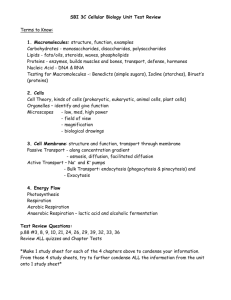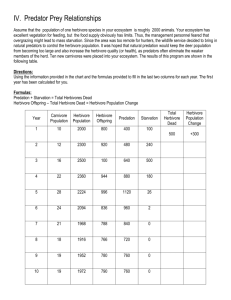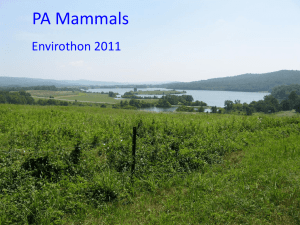Recitation Section 14 Answer Key Biogeochemical Cycles
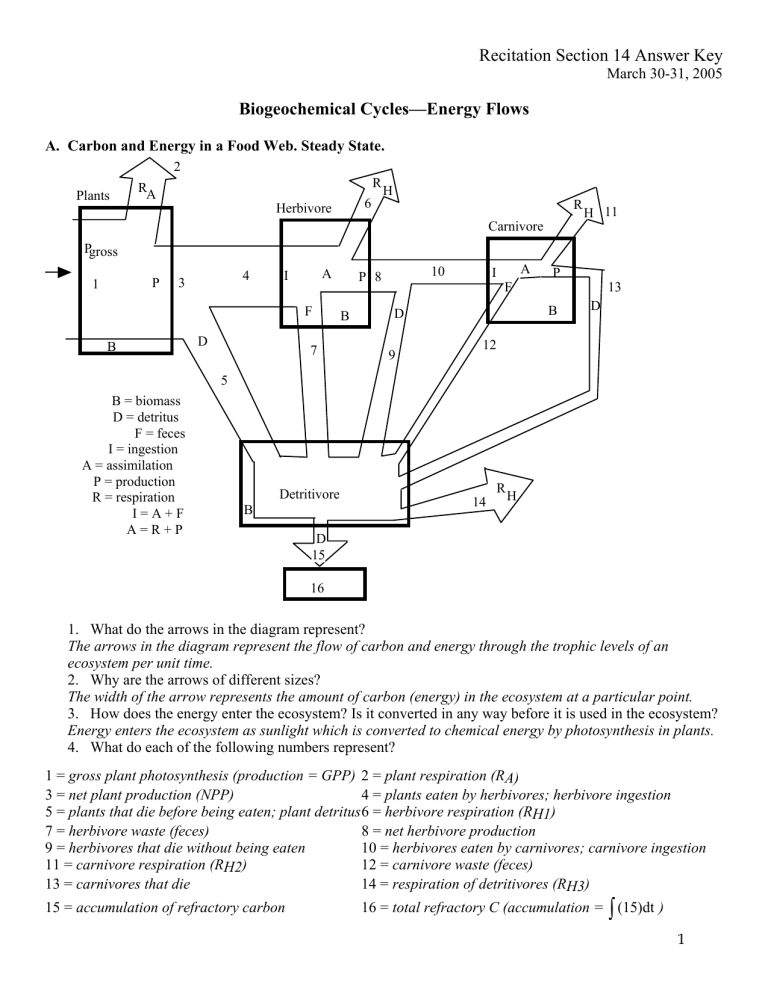
Recitation Section 14 Answer Key
March 30-31, 2005
Biogeochemical Cycles—Energy Flows
A.
Carbon and Energy in a Food Web. Steady State.
2
Plants
R
A
Herbivore
6
R
H
R
H 11
Carnivore
Pgross
1 P 3
4 I A
P 8
10 I
F
A
P
13
F
B D
B
D
B
D
7
9
12
5
B = biomass
D = detritus
F = feces
I = ingestion
A = assimilation
P = production
R = respiration
I = A + F
A = R + P
B
Detritivore
D
15
14
R
H
16
1.
What do the arrows in the diagram represent?
The arrows in the diagram represent the flow of carbon and energy through the trophic levels of an ecosystem per unit time.
2.
Why are the arrows of different sizes?
The width of the arrow represents the amount of carbon (energy) in the ecosystem at a particular point.
3.
How does the energy enter the ecosystem? Is it converted in any way before it is used in the ecosystem?
Energy enters the ecosystem as sunlight which is converted to chemical energy by photosynthesis in plants.
4.
What do each of the following numbers represent?
1 = gross plant photosynthesis (production = GPP) 2 = plant respiration (RA)
3 = net plant production (NPP) 4 = plants eaten by herbivores; herbivore ingestion
5 = plants that die before being eaten; plant detritus 6 = herbivore respiration (RH1)
7 = herbivore waste (feces) 8 = net herbivore production
9 = herbivores that die without being eaten
11 = carnivore respiration (RH2) 12
13 = carnivores that die 14 = respiration of detritivores (RH3)
15 = accumulation of refractory carbon 16
∫
(15)dt )
1
5.
Starting with 10 6 kcal/yr of GPP and given the following values, estimate the values of each of the flows from part 4 assuming steady-state conditions.
NPP
For plants : net production efficiency =
GPP
=
50% ingestion
For the herbivores: exploitation efficiency = production from previous trophic level assimilation assimilation efficiency =
=
25% ingestion production
= assimilation
=
20%
For the carnivores: exploitation efficiency = 90% (no reference)
= 20% b)
Plants
500,000
R
A
R
H
20,000
Herbivore light
Pgross
P
500,000
10
6
B
D
100,000 I
25,000
A
F
B
P 5,000
D
75,000
500
400,000
3,375
Carnivore
3206
R
H
4,500 I
F
A
P
B
1125
169
D
Detritvore
476,794
R
H
B
D
0
6.
The carbon in respiration (R) flows can be used by other organisms, but the energy in the respiration (R) flows cannot. Both the carbon and energy of all other flows can be used by other organisms. What is different about the R flows?
The R flows are unique in that they represent energy expended by the organism to move, eat, maintain homeostasis, etc. This represents the loss of the energy in the form of heat. This is the energy consumed by the organism; it is therefore unavailable for use by other trophic levels. All other flows represent organic carbon (“glucose”) which can be “burned” via respiration (aerobic mostly, but anaerobic respiration & fermentation also use up some) to release energy. This organic carbon can also be used to make biomass, waste, etc. The R flows represent CO
2
which can only be used by autotrophs (oxygenic photosynthesis mostly, but also anoxygenic photosynthesis and chemosynthesis) to be fixed into organic carbon.
2
B.
Non-Steady State.
Now consider the non-steady-state. Suppose you remove 50% of the herbivores at time = A. You then measure the plant-associated flows and find the following:
5
10 kcal/yr
15 1 1
(
(gross plant production)
(12)
10
5
(6)
(7.5)
2
(plant respiration)
(5.5)
5
(plant detritus)
(2)
(1)
(2)
(herbivore
4 injestion)
0
A B C
1.
What is going on? Consider the state of the ecosystem at times B and C.
At time = A, the system is at steady state (1 = 2 + 4 + 5) with a low amount of plant biomass. “The cows are eating a lot of the grass.” Removing the “cows” allows some of the grass to grow back. This is what is happening at time = B. Here, there is net increase in plant biomass (1 - (2 + 4 + 5) = 3x105 kcal/yr).
Eventually, the grass gets crowded & starts to die at a greater rate, resulting in a new steady state at time =
C.
3
